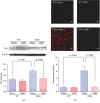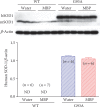Bidens pilosa Extract Administered after Symptom Onset Attenuates Glial Activation, Improves Motor Performance, and Prolongs Survival in a Mouse Model of Amyotrophic Lateral Sclerosis
- PMID: 32089764
- PMCID: PMC7008255
- DOI: 10.1155/2020/1020673
Bidens pilosa Extract Administered after Symptom Onset Attenuates Glial Activation, Improves Motor Performance, and Prolongs Survival in a Mouse Model of Amyotrophic Lateral Sclerosis
Abstract
Amyotrophic lateral sclerosis (ALS) is a late-onset neurodegenerative disorder characterized by progressive paralysis resulting from the death of upper and lower motor neurons. There is currently no effective pharmacological treatment for ALS, and the two approved drugs riluzole and edaravone have limited effects on the symptoms and only slightly prolong the life of patients. Therefore, the development of effective therapeutic strategies is of paramount importance. In this study, we investigated whether Miyako Island Bidens pilosa (MBP) can alleviate the neurological deterioration observed in a superoxide dismutase-1 G93A mutant transgenic mouse (G93A mouse) model of ALS. We orally administered 2 g/kg/day of MBP to G93A mice at the onset of symptoms of neurodegeneration (15 weeks old) until death. Treatment with MBP markedly prolonged the life of ALS model mice by approximately 20 days compared to that of vehicle-treated ALS model mice and significantly improved motor performance. MBP treatment prevented the reduction in SMI32 expression, a neuronal marker protein, and attenuated astrocyte (detected by GFAP) and microglia (detected by Iba-1) activation in the spinal cord of G93A mice at the end stage of the disease (18 weeks old). Our results indicate that MBP administered after the onset of ALS symptoms suppressed the inflammatory activation of microglia and astrocytes in the spinal cord of the G93A ALS model mice, thus improving their quality of life. MBP may be a potential therapeutic agent for ALS.
Copyright © 2020 Yasuhiro Kosuge et al.
Conflict of interest statement
The authors declare that they have no conflicts of interest.
Figures







Similar articles
-
Anti-Inflammatory Effects of Miyako Bidens pilosa in a Mouse Model of Amyotrophic Lateral Sclerosis and Lipopolysaccharide-Stimulated BV-2 Microglia.Int J Mol Sci. 2023 Sep 5;24(18):13698. doi: 10.3390/ijms241813698. Int J Mol Sci. 2023. PMID: 37762010 Free PMC article.
-
Toll-Like Receptor-4 Inhibitor TAK-242 Attenuates Motor Dysfunction and Spinal Cord Pathology in an Amyotrophic Lateral Sclerosis Mouse Model.Int J Mol Sci. 2017 Aug 1;18(8):1666. doi: 10.3390/ijms18081666. Int J Mol Sci. 2017. PMID: 28763002 Free PMC article.
-
Guanabenz delays the onset of disease symptoms, extends lifespan, improves motor performance and attenuates motor neuron loss in the SOD1 G93A mouse model of amyotrophic lateral sclerosis.Neuroscience. 2014 Sep 26;277:132-8. doi: 10.1016/j.neuroscience.2014.03.047. Epub 2014 Mar 31. Neuroscience. 2014. PMID: 24699224
-
[Development of motor neuron restorative therapy in amyotrophic lateral sclerosis using hepatocyte growth factor].Rinsho Shinkeigaku. 2009 Nov;49(11):814-7. doi: 10.5692/clinicalneurol.49.814. Rinsho Shinkeigaku. 2009. PMID: 20030218 Review. Japanese.
-
Therapeutic news in ALS.Rev Neurol (Paris). 2021 May;177(5):544-549. doi: 10.1016/j.neurol.2020.12.003. Epub 2021 Mar 26. Rev Neurol (Paris). 2021. PMID: 33781562 Review.
Cited by
-
Herbal medicines for SOD1G93A mice of amyotrophic lateral sclerosis: preclinical evidence and possible immunologic mechanism.Front Immunol. 2024 Sep 17;15:1433929. doi: 10.3389/fimmu.2024.1433929. eCollection 2024. Front Immunol. 2024. PMID: 39355247 Free PMC article.
-
Intranasal Administration of N-acetyl-L-cysteine Combined with Cell-Penetrating Peptide-Modified Polymer Nanomicelles as a Potential Therapeutic Approach for Amyotrophic Lateral Sclerosis.Pharmaceutics. 2022 Nov 24;14(12):2590. doi: 10.3390/pharmaceutics14122590. Pharmaceutics. 2022. PMID: 36559085 Free PMC article.
-
Peripheral and Central Nervous System Immune Response Crosstalk in Amyotrophic Lateral Sclerosis.Front Neurosci. 2020 Jun 16;14:575. doi: 10.3389/fnins.2020.00575. eCollection 2020. Front Neurosci. 2020. PMID: 32612503 Free PMC article. Review.
-
Anti-Inflammatory Effects of Miyako Bidens pilosa in a Mouse Model of Amyotrophic Lateral Sclerosis and Lipopolysaccharide-Stimulated BV-2 Microglia.Int J Mol Sci. 2023 Sep 5;24(18):13698. doi: 10.3390/ijms241813698. Int J Mol Sci. 2023. PMID: 37762010 Free PMC article.
-
Miyako Bidens pilosa Extract Ameliorates Allodynia and Suppresses Spinal Microglial Activation in Mice with Partial Sciatic Nerve Ligation.Curr Issues Mol Biol. 2025 Jun 12;47(6):453. doi: 10.3390/cimb47060453. Curr Issues Mol Biol. 2025. PMID: 40699852 Free PMC article.
References
MeSH terms
Substances
LinkOut - more resources
Full Text Sources
Medical
Miscellaneous

